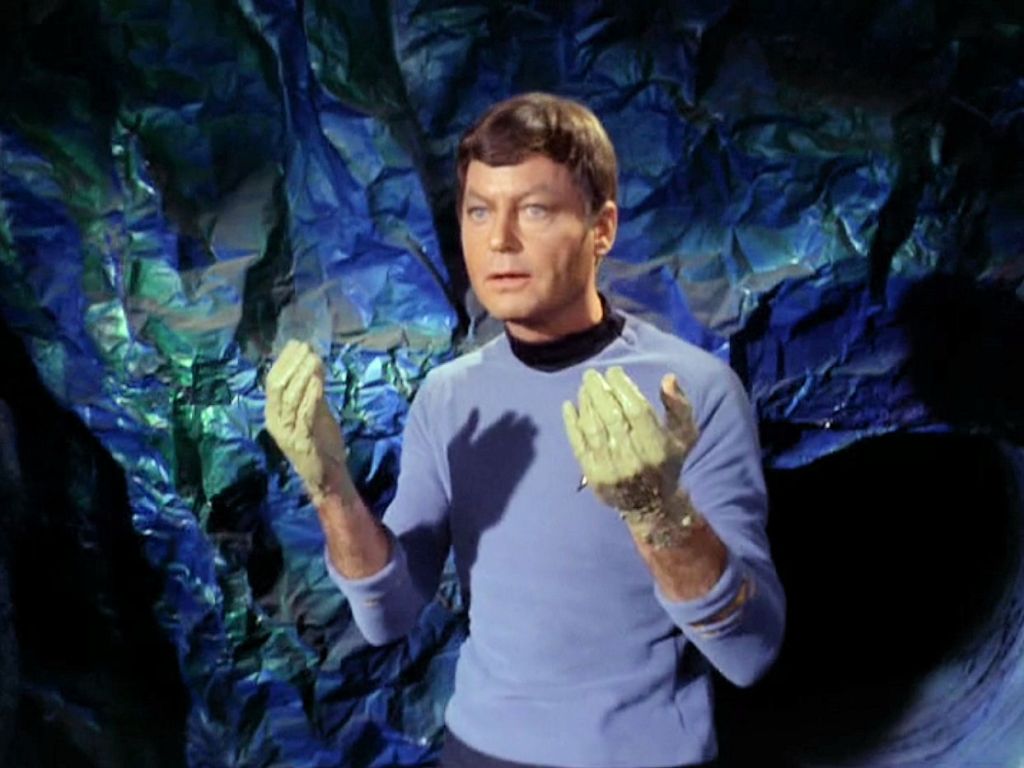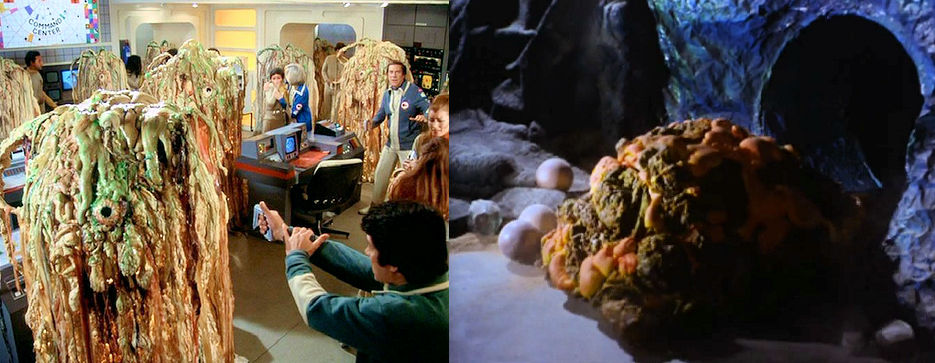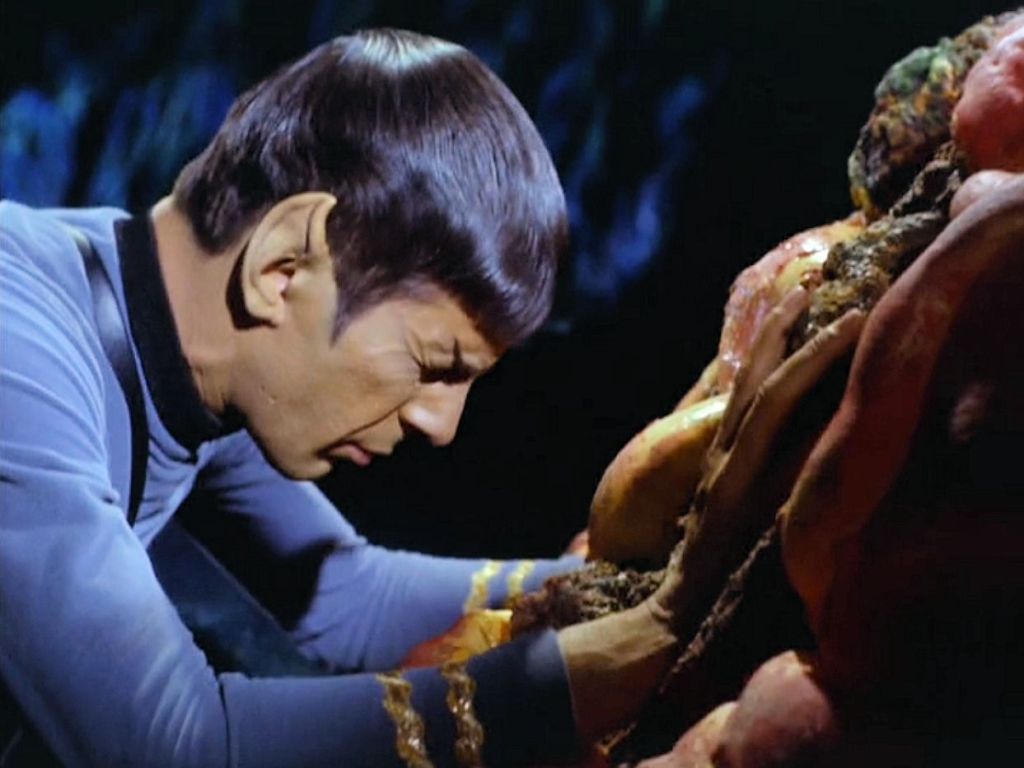(Note: This post is viewable as a page elsewhere on this site. If you haven’t read it yet, my introductory post on this Star Trek: The Original Series rewatch is a good place to start. Previous essays on specific episodes can be found here.)
Original Air Date: March 9, 1967
Crew Death Count: 1 (an Enterprise security officer is killed by the Horta; fifty members of the Janus VI mining colony died in backstory, plus two more during the episode)
Bellybuttons: 0 (technically, we don’t know if the Horta even has a bellybutton)
The stark message of “The Devil in the Dark” is as relevant today as it was in 1967: don’t let anyone convince you lives must be sacrificed in the name of commerce. Because it’s not true.
Or is it?
This week, we learn that pergium miners on the planet Janus VI are being killed by what they believe to be some sort of monster. Fifty have died so far. The Enterprise crew, represented by Kirk, Spock, McCoy, Scott, and a security team, arrives to sort out the problem. We don’t know pergium’s exact purpose, but it must be important, because Kirk tells us “a dozen planets” depend on it and the current shortage is causing even life support systems to fail. Whatever pergium is, a lot of the Federation’s citizens are counting on it. Kirk and Spock determine the “devil in the dark” to be a species indigenous to Janus VI, the Horta, a rare silicon-based life form. The miners had inadvertently entered a chamber of Horta eggs and the surviving Horta defended those eggs the only way it knew how.

The pergium miners are not as crude as the lithium miners from “Mudd’s Women,” but they have a simplistic, production-oriented world view. They have “a quota to meet,” and any obstacle to that duty must be removed. Hence they think nothing of the piles of silicon nodules they’ve encountered, as the nodules have “no commercial value.” Spock, with his more expansive world view, immediately identifies the nodules as “a geologic oddity” and begins piecing together their purpose (and he’s smart enough to qualify his description of Janus VI as containing “no life as we know it”). The miners are also inconsistent in their attitude toward the very people trying to save them, like Republican retirees who claim government is inherently evil while demanding their next Social Security check. In the episode’s prologue, one miner breathlessly asks, “Is it true the Enterprise is on its way?” Clearly, NCC-1701 has a favorable reputation in these parts. Yet once the ship arrives, the miners are antagonistic, criticizing Kirk for no reason (“You’re all pretty tough, aren’t you?”) and even going so far as to attack a group of Enterprise security officers. Of course, the perpetually lame security force is easily subdued, but shouldn’t the miners suffer consequences for this assault? We understand the miners’ frustration, if not their actions: they are clearly under significant pressure to produce, and they’re stuck with outdated equipment, the likes of which Mr. Scott hasn’t seen in twenty years.

The miners’ very existence demonstrates that the Federation may be post-capitalist, but it still has material needs, and those needs have an environmental impact. The truth is that doing anything on a large scale makes long-term sustainability nearly impossible; even 21st century attempts at “green” living are often not so green, after all. Electric cars might put a dent in fossil fuel consumption, but they maintain all the other burdens of a car-centric society. Warehouses full of caged chickens laying eggs for our breakfast seems terribly cruel, but it turns out that free range chicken farms are also not so “free.” In the Federation’s reliance on pergium (can’t all that brainpower come up alternatives?), it is trampling on the indigenous life of Janus VI. We can only imagine what horrors might be occurring on other planets; try not to think about the sex trafficking in “Mudd’s Women!” In fact, large-scale commerce will always cost lives, regardless of what measures we take to delay the inevitable. Uneasy alliances and shiny new technology won’t save us from the path we’re on; only responsible living and reduced consumption will do that.
So despite the miners’ mixed reactions to the arrival of the Enterprise, our crew conducts itself admirably, with the possible exception of McCoy (and the aforementioned red-shirts). The doctor behaves primarily in the same complaining fashion as he did in “A Taste of Armageddon.” First, he argues against the possibility of silicon-based life when Spock puts forth the idea. Then, he drags his feet on helping the very real silicon-based Horta after it’s injured: “You can’t be serious. That thing is virtually made out of stone.”

Kirk, conversely, is the captain who knows how to keep his crew on task; officers aren’t just along for the ride, they’re expected to fulfill their duties as subject-matter experts. “You’re a healer,” Kirk reminds McCoy as he points to the Horta. “That’s a patient.” He does the same with Scott, ordering his hesitant chief engineer to work a miracle in repairing the miners’ damaged equipment. Likewise, Kirk puts his first officer’s unique skill set to work: while Spock nearly panics at the prospect of Kirk dying in a tunnel collapse, and practically begs Kirk to kill the Horta when it confronts the captain directly, Kirk doesn’t hesitate to send Spock into harm’s way. When the Horta allows an uneasy truce in the mine tunnels, Kirk directs Spock to attempt a highly risky mind-meld to establish a dialogue (in fairness, the mind-meld was Spock’s idea). Kirk doesn’t revisit the risk involved when he instructs his crew to honor their mission: they knew the job was dangerous when they took it. Galactic exploration doesn’t come with an instruction manual, and sometimes explorers have to learn on the job, a lesson Kirk shares with Saavik in Star Trek II: The Wrath of Khan (1982) when he says, “We learn by doing.”
Kirk’s leadership does go off the rails a couple of times, however. Kirk and Spock are first on the scene when a security officer is killed early in the search for the Horta. Within minutes, when other security personnel arrive and ask, “Are you all right, Captain?” he simply says, “Yes, perfectly,” with no mention of the crew member just killed! Failing to even acknowledge a colleague’s death seems bad for crew morale. Kirk also makes a significant misstatement when the Horta is injured; he tells the security team, “There’s nothing more dangerous than a wounded animal.” Where has he been? Never mind his own previous orders to “shoot to kill” the Horta on sight, or his rapid-onset amnesia over the death of his own crewman. This is the guy who tried to rape a yeoman in “The Enemy Within” and casually risked interstellar war in both “Balance of Terror” and “Arena.” History has shown that a guy with a chip on his shoulder and access to weapons is the greatest threat to life in any century.

The dramatic talk, thankfully, ends up being all bluster, as it’s Kirk who finally establishes first contact with the Horta. Perhaps Spock’s words of caution have had time to sink in. It’s Spock who urges restraint when Kirk issues the “shoot to kill” order, having already deduced that the Horta may be the last of its kind and “to kill it would be a crime against science” (or a plain-old crime, for that matter, considering humans are the real intruders here). The miners assume the Horta is a mindless digging creature, but it’s wise enough to steal the one component Janus VI needs to continue operating. It’s human nature to assume a life form lacks sentience if it can’t communicate with us on our terms. Then the Horta does communicate on our terms, carving “No Kill I” into solid rock, demonstrating brilliant linguistic insight, because the line works both ways – as a promise not to kill, or a plea to humans not to kill it. Spock’s mind-meld with the Horta reveals its full intelligence and the complicated backstory, that every 50,000 years all the Hortas die except one, to safeguard the next generation of Horta eggs. It’s an efficient means of population control, but highly risky if the one survivor should die. We’re left to wonder – why did the eggs need protecting in the first place? Is a natural Horta predator present on Janus VI? Perhaps the Horta is related to the aliens from “The Bringers of Wonder” episode of Space: 1999?

Whatever the Horta’s nature, its moral must have seemed as relevant in 1967 as it is today. When lines were crossed, redrawn, and crossed again between black and white, man and woman, pacifist and militant, young and old, blue collar and white collar, revisiting the Biblical message that “Thou shalt love thy neighbor as thyself” couldn’t hurt. The conclusion of that passage, “There is none other commandment greater,” seems clear enough – we should put both consumption and commerce aside and care for one another instead.

On that basis, Kirk works out a somewhat lop-sided truce between the Horta and the miners. The miners stop killing Horta eggs and the Horta digs tunnels to open up deposits of valuable resources (valuable to Starfleet, at least). We can predict that the balance of power may shift as the miners expand their presence on Janus VI. Better, perhaps, to hope this is the beginning of a long-term alliance of mutual respect, with the miners of Janus VI learning that cooperation, loving their neighbor, is sometimes the easiest route to get what they want. Janus was, after all, the Roman god of beginnings and transitions. Often represented as two faces gazing in opposite directions, Janus reigned over the change from past to future, from youth to maturity, or from barbarism to civilization. “The Devil in the Dark” marks a transition to greater awareness for the Federation, Kirk, Spock, McCoy, the miners, even Star Trek fans: over the end credits of “The Devil in the Dark,” NBC announced that TOS had been renewed for a second season. The galaxy is too big to be inhabited only by carbon-based life, too vast to explore in only one season, and too diverse to encounter with a closed mind. If it’s true that life is change, we’ve come to the right place, as long as we’re ready to admit that sometimes, the burden of change belongs with us.
Next: Errand of Mercy
I love your analyses! You’re right about the main theme of the story being relevant today as well as when the episode first came out.
As for commerce and production in the TOS utopia, to me this is telling of the fact that Roddenberry didn’t really have a clear idea of the “perfect” future of the Federation in the early stages of series… But then he sort of adjusted the whole thing to what we all have in mind when we think of it!
LikeLiked by 1 person
Thank you! This is a new kind of writing for me. Plus, I’m really enjoying revisiting the series in close detail. I appreciate the kind words!
LikeLike